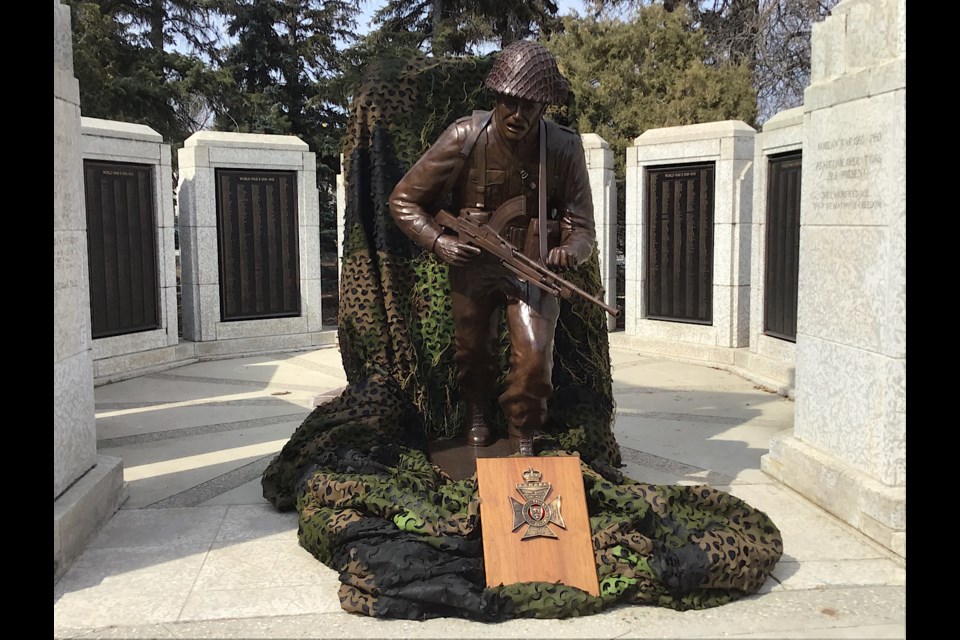REGINA - A statue which will be placed in France to commemorate the landing of the Royal Regina Rifles made its way to the grounds of the Legislature this weekend.
The statue was displayed at a special public 小蓝视频 at the Saskatchewan War Memorial on April 6. The 小蓝视频 was attended by military personnel and several local and provincial dignitaries, including Lt.-Governor Russ Mirasty. A flyover from two Royal Canadian Air Force CT 155 Harvard II aircraft from CFB Moose Jaw was among the highlights of the festivities Saturday.
The legislature grounds are just one stop for the statue. It will make a stop on the Peepeekisis First Nation and then be transported over to Bretteville-Sur-Mer, France where it will be officially unveiled and permanently displayed. That 小蓝视频 will coincide with the 80th anniversary of the Rifles’ storming of Juno Beach on June 6, 1944.
A number of current and retired Royal Regina Rifles will be heading to France in early June to accompany the statue for that tour, called the Battlefield Tour of Honour. The province is providing a $40,000 grant to support that 10-day tour in an initiative named Operation Calvados.
The Regina Rifle Regiment consisted of young men from across Saskatchewan, and they are among the first infantry regiments to land on the western side of Juno Beach as part of the D-Day invasion called Operation Overlord. The regiment went on to clear the village of Courseulles-sur-Mer and would go on their way towards Germany.
The Regina Rifles paid a steep price for their efforts, losing 102 during the D-Day invasion and ultimately losing 458 members in the war.
The statue to commemorate the Rifles was created by sculptor Don Begg. It is an eight foot bronze statue that depicts a member of the Rifles seen charging ahead into battle, with the strain and stress of war etched on his face — a depiction which captures the bravery and determination of all of those who took part from the regiment.
Begg said that he tried to convey on the face of the soldier the “fear, a determination, the unknown, but you had a job to do, you were asked to do it and you were going to do it.”
He told reporters they came up with an eight foot figure “because it’s going to be out on a place where people can walk by at a distance.” There was also attention paid to details on what the soldiers wore at the time, including the helmet and boots.
Because the statue is made of bronze, “it’s going to last for thousands of years after we are long gone, so you always try to do your best, because you won’t be around to make excuses.”
Begg said it was a great honour to be asked to do the statue. As for what he hoped people would take away from seeing it, he wanted them to know “they were fighting for their country, and they were volunteers… 99 per cent of these were all volunteers, they were doctors or lawyers or farmers, just anybody to do, and they were out to get our freedom that we have today.”
During the ceremonies Saturday, tribute was paid to one Saskatchewan veteran who took part in the Second World War as an anti-aircraft gunner: Nick Kazuska, age 104, of Saskatoon. The French ambassador Michel Miraillet was on hand to pay tribute to Kazuska’s service by presenting him with the French Legion of Honour medal.
“It was the first job I took,” Kazuska said of his war service. When he returned to Saskatchewan, he worked as a grain buyer and was an active musician and bass player.
He accepted his honour with humility. “I’m happy to see so many people here,” he said to reporters, and he said of the statue that he “feels great about that.”
“Mr. Kazuska is a symbol of those Canadian combatants we are decorating,” said Miraillet. He said Canadians “can be proud of what those veterans did.”
“In a sense what Kazuska did — going to war, going to France, going from the deep part of Saskatchewan which is very far away from Calvados and other places — it seems for us it’s a symbol of the capacity of this country, of this democracy to act in order to defend those values we share in common between the French and Canadians. By decorating and giving the Legion of Honour to this man it’s also a way for us to remember that we realize the Canadian commitments to defend democracy, militarily speaking.”
“It’s a real sense of pride,” said Lieutenant-colonel Ed Staniowski, Retired, of the Royal Regina Rifles, in speaking of the commemorations on Saturday. Staniowski was lead planner for the Royal Regina Rifles Trust for the 80th anniversary and said he was able to see the statue from conception to finished statue.
“It’s a real thrill for me to be able to see that the legacy of this great regiment is continuing,” said Staniowski. “When you see it for real, the size of it, the intensity of it it’s very moving. It’s something that has stuck with me. I’ve had a chance to serve with the Canadian Armed Forces in the regiment in various places in the world in several conflicts, and the intensity that is on that statute is what you see on the faces of Canadian men and women when they serve on far off places in the world.”
Staniowski said it was a thrill for him to “think we could commemorate” those who fought in the war, and “pass on that legacy today, and it’s very important. The world’s a dangerous place… That needs to be remembered. It was a terrible, terrible price that was paid in the Second World War and we don’t want to see that again.”




